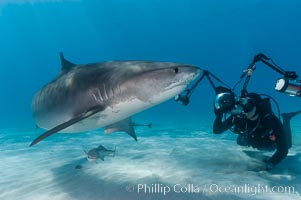
Tiger shark and photographer Keith Grundy.
Species: Tiger shark, Galeocerdo cuvier
Location: Bahamas
Image ID: 10649
Species: Tiger shark, Galeocerdo cuvier
Location: Bahamas
Image ID: 10649
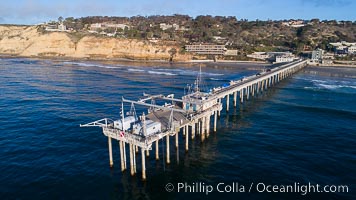
Aerial Photo of Scripps Pier. SIO Pier. The Scripps Institution of Oceanography research pier is 1090 feet long and was built of reinforced concrete in 1988, replacing the original wooden pier built in 1915. The Scripps Pier is home to a variety of sensing equipment above and below water that collects various oceanographic data. The Scripps research diving facility is located at the foot of the pier. Fresh seawater is pumped from the pier to the many tanks and facilities of SIO, including the Birch Aquarium. The Scripps Pier is named in honor of Ellen Browning Scripps, the most significant donor and benefactor of the Institution.
Location: Scripps Institution of Oceanography, La Jolla, California
Image ID: 38231
Location: Scripps Institution of Oceanography, La Jolla, California
Image ID: 38231
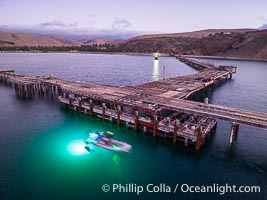
Rapid Bay Jetty Aerial Photo, South Australia. The now-derelict jetty (wharf, pier) at Rapid Bay is famous for great SCUBA diving, including opportunities to see leafy sea dragons.
Location: Rapid Bay Jetty, South Australia
Image ID: 39217
Location: Rapid Bay Jetty, South Australia
Image ID: 39217
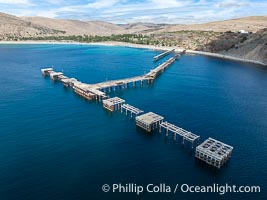
Rapid Bay Jetty Aerial Photo, South Australia. The now-derelict jetty (wharf, pier) at Rapid Bay is famous for great SCUBA diving, including opportunities to see leafy sea dragons.
Location: Rapid Bay Jetty, South Australia
Image ID: 39218
Location: Rapid Bay Jetty, South Australia
Image ID: 39218
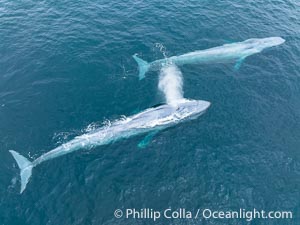
Aerial photo of two blue whales near San Diego. These enormous blue whales glide at the surface of the ocean, resting and breathing before diving to feed on subsurface krill.
Species: Blue whale, Balaenoptera musculus
Location: San Diego, California
Image ID: 39420
Species: Blue whale, Balaenoptera musculus
Location: San Diego, California
Image ID: 39420
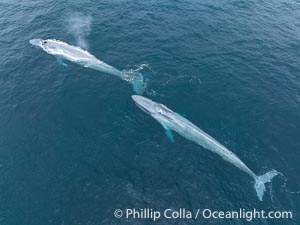
Aerial photo of two blue whales near San Diego. These enormous blue whales glide at the surface of the ocean, resting and breathing before diving to feed on subsurface krill.
Species: Blue whale, Balaenoptera musculus
Location: San Diego, California
Image ID: 39426
Species: Blue whale, Balaenoptera musculus
Location: San Diego, California
Image ID: 39426
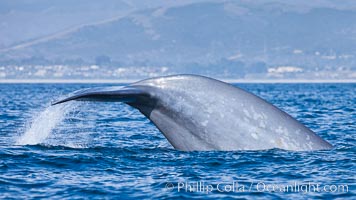
Blue whale, raising fluke prior to diving for food, fluking up, lifting tail as it swims in the open ocean foraging for food.
Species: Blue whale, Balaenoptera musculus
Location: Dana Point, California
Image ID: 27341
Species: Blue whale, Balaenoptera musculus
Location: Dana Point, California
Image ID: 27341
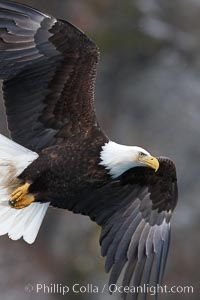
Bald eagle in flight, banking at a steep angle before turning and diving, wings spread.
Species: Bald eagle, Haliaeetus leucocephalus, Haliaeetus leucocephalus washingtoniensis
Location: Kenai Peninsula, Alaska
Image ID: 22645
Species: Bald eagle, Haliaeetus leucocephalus, Haliaeetus leucocephalus washingtoniensis
Location: Kenai Peninsula, Alaska
Image ID: 22645
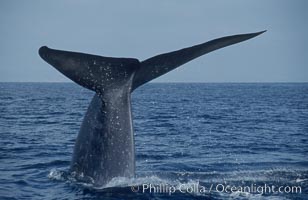
An enormous blue whale raises its fluke (tail) high out of the water before diving. Open ocean offshore of San Diego.
Species: Blue whale, Balaenoptera musculus
Location: San Diego, California
Image ID: 07556
Species: Blue whale, Balaenoptera musculus
Location: San Diego, California
Image ID: 07556
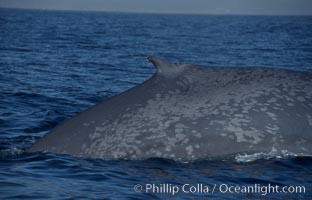
An enormous blue whale rounds out (hunches up its back) before diving. Note the distinctive mottled skin pattern and small, falcate dorsal fin. Open ocean offshore of San Diego.
Species: Blue whale, Balaenoptera musculus
Location: San Diego, California
Image ID: 07573
Species: Blue whale, Balaenoptera musculus
Location: San Diego, California
Image ID: 07573
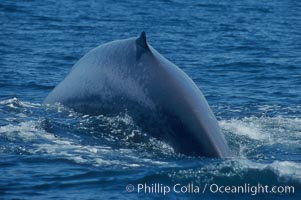
An enormous blue whale rounds out (hunches up its back) before diving. Note the distinctive mottled skin pattern and small, falcate dorsal fin. Open ocean offshore of San Diego.
Species: Blue whale, Balaenoptera musculus
Location: San Diego, California
Image ID: 07577
Species: Blue whale, Balaenoptera musculus
Location: San Diego, California
Image ID: 07577
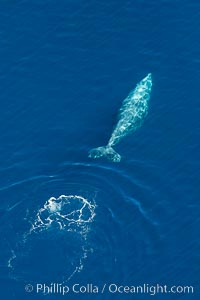
Gray whale diving below the ocean surface, leaving a footprint in its wake. Aerial photo.
Species: Gray whale, Eschrichtius robustus
Location: Encinitas, California
Image ID: 29037
Species: Gray whale, Eschrichtius robustus
Location: Encinitas, California
Image ID: 29037
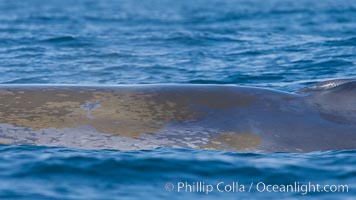
Blue whale rounding out at surface, before diving for food, showing characteristic blue/gray mottled skin pattern.
Species: Blue whale, Balaenoptera musculus
Location: Dana Point, California
Image ID: 27346
Species: Blue whale, Balaenoptera musculus
Location: Dana Point, California
Image ID: 27346
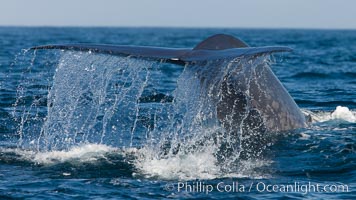
Blue whale, raising fluke prior to diving for food, fluking up, lifting tail as it swims in the open ocean foraging for food.
Species: Blue whale, Balaenoptera musculus
Location: Dana Point, California
Image ID: 27353
Species: Blue whale, Balaenoptera musculus
Location: Dana Point, California
Image ID: 27353
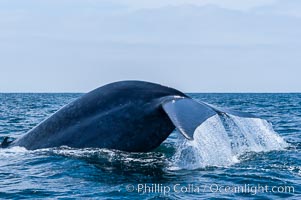
A blue whale raises its fluke before diving in search of food. The blue whale is the largest animal on earth, reaching 80 feet in length and weighing as much as 300,000 pounds. Near Islas Coronado (Coronado Islands).
Species: Blue whale, Balaenoptera musculus
Location: Coronado Islands (Islas Coronado), Baja California, Mexico
Image ID: 09481
Species: Blue whale, Balaenoptera musculus
Location: Coronado Islands (Islas Coronado), Baja California, Mexico
Image ID: 09481
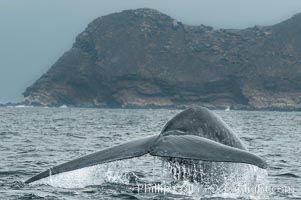
A blue whale raises its fluke before diving in search of food. The blue whale is the largest animal on earth, reaching 80 feet in length and weighing as much as 300,000 pounds. North Coronado Island is in the background.
Species: Blue whale, Balaenoptera musculus
Location: Coronado Islands (Islas Coronado), Baja California, Mexico
Image ID: 09484
Species: Blue whale, Balaenoptera musculus
Location: Coronado Islands (Islas Coronado), Baja California, Mexico
Image ID: 09484
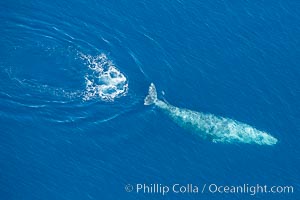
Gray whale diving below the ocean surface, leaving a footprint in its wake. Aerial photo.
Species: Gray whale, Eschrichtius robustus
Location: Encinitas, California
Image ID: 29038
Species: Gray whale, Eschrichtius robustus
Location: Encinitas, California
Image ID: 29038
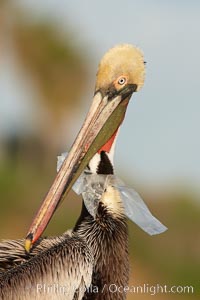
A California brown pelican entangled in a plastic bag which is wrapped around its neck. This unfortunate pelican probably became entangled in the bag by mistaking the floating plastic for food and diving on it, spearing it in such a way that the bag has lodged around the pelican's neck. Plastic bags kill and injure untold numbers of marine animals each year.
Species: Brown Pelican, Pelecanus occidentalis, Pelecanus occidentalis californicus
Location: La Jolla, California
Image ID: 22564
Species: Brown Pelican, Pelecanus occidentalis, Pelecanus occidentalis californicus
Location: La Jolla, California
Image ID: 22564
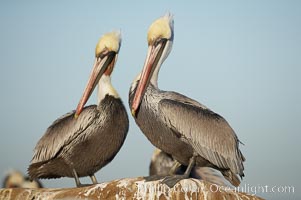
Brown pelicans preening. After wiping its long beak on the uropygial gland near the base of its tail, the pelican spreads the preen oil on feathers about its body, helping to keep them water resistant, an important protection for a bird that spends much of its life diving in the ocean for prey. Adult winter non-breeding plumage showing white hindneck.
Species: Brown Pelican, Pelecanus occidentalis, Pelecanus occidentalis californicus
Location: La Jolla, California
Image ID: 20089
Species: Brown Pelican, Pelecanus occidentalis, Pelecanus occidentalis californicus
Location: La Jolla, California
Image ID: 20089
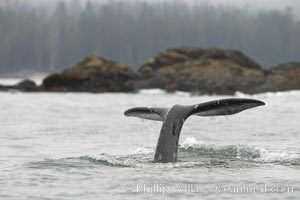
Gray whale, raising its fluke (tail) before diving to the ocean floor to forage for crustaceans, , Cow Bay, Flores Island, near Tofino, Clayoquot Sound, west coast of Vancouver Island.
Species: Gray whale, Eschrichtius robustus
Location: Cow Bay, Flores Island, British Columbia, Canada
Image ID: 21173
Species: Gray whale, Eschrichtius robustus
Location: Cow Bay, Flores Island, British Columbia, Canada
Image ID: 21173
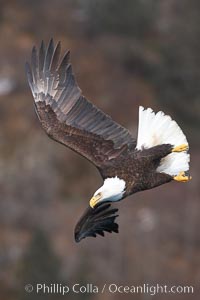
Bald eagle in flight, banking at a steep angle before turning and diving, wings spread.
Species: Bald eagle, Haliaeetus leucocephalus, Haliaeetus leucocephalus washingtoniensis
Location: Kenai Peninsula, Alaska
Image ID: 22653
Species: Bald eagle, Haliaeetus leucocephalus, Haliaeetus leucocephalus washingtoniensis
Location: Kenai Peninsula, Alaska
Image ID: 22653
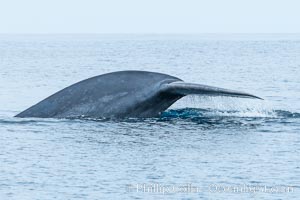
Blue whale raising fluke, prior to diving for food, fluking up, lifting its tail as it swims in the open ocean foraging for food.
Species: Blue whale, Balaenoptera musculus
Location: San Diego, California
Image ID: 34559
Species: Blue whale, Balaenoptera musculus
Location: San Diego, California
Image ID: 34559
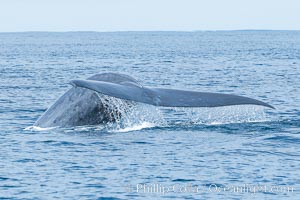
Blue whale raising fluke, prior to diving for food, fluking up, lifting its tail as it swims in the open ocean foraging for food.
Species: Blue whale, Balaenoptera musculus
Location: San Diego, California
Image ID: 34562
Species: Blue whale, Balaenoptera musculus
Location: San Diego, California
Image ID: 34562
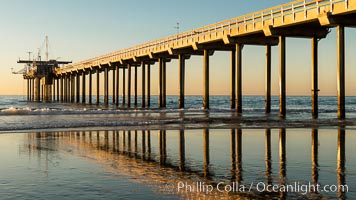
SIO Pier. The Scripps Institution of Oceanography research pier is 1090 feet long and was built of reinforced concrete in 1988, replacing the original wooden pier built in 1915. The Scripps Pier is home to a variety of sensing equipment above and below water that collects various oceanographic data. The Scripps research diving facility is located at the foot of the pier. Fresh seawater is pumped from the pier to the many tanks and facilities of SIO, including the Birch Aquarium. The Scripps Pier is named in honor of Ellen Browning Scripps, the most significant donor and benefactor of the Institution.
Location: Scripps Institution of Oceanography, La Jolla, California
Image ID: 36558
Location: Scripps Institution of Oceanography, La Jolla, California
Image ID: 36558
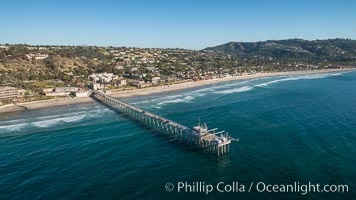
Aerial Photo of Scripps Pier. SIO Pier. The Scripps Institution of Oceanography research pier is 1090 feet long and was built of reinforced concrete in 1988, replacing the original wooden pier built in 1915. The Scripps Pier is home to a variety of sensing equipment above and below water that collects various oceanographic data. The Scripps research diving facility is located at the foot of the pier. Fresh seawater is pumped from the pier to the many tanks and facilities of SIO, including the Birch Aquarium. The Scripps Pier is named in honor of Ellen Browning Scripps, the most significant donor and benefactor of the Institution.
Image ID: 30737
Image ID: 30737
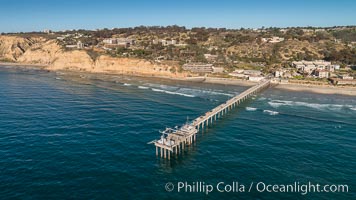
Aerial Photo of Scripps Pier. SIO Pier. The Scripps Institution of Oceanography research pier is 1090 feet long and was built of reinforced concrete in 1988, replacing the original wooden pier built in 1915. The Scripps Pier is home to a variety of sensing equipment above and below water that collects various oceanographic data. The Scripps research diving facility is located at the foot of the pier. Fresh seawater is pumped from the pier to the many tanks and facilities of SIO, including the Birch Aquarium. The Scripps Pier is named in honor of Ellen Browning Scripps, the most significant donor and benefactor of the Institution.
Image ID: 30738
Image ID: 30738
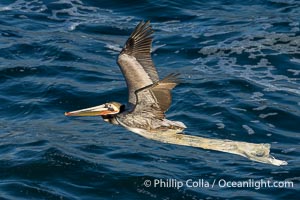
Brown pelican flying while entangled in plastic bag wrapped around its neck. I believe the pelican probably became entangled in the bag by mistaking the floating plastic for food and diving on it, spearing it in such a way that the bag has lodged around the pelican's neck.
Species: Brown Pelican, Pelecanus occidentalis californicus, Pelecanus occidentalis
Location: La Jolla, California
Image ID: 40106
Species: Brown Pelican, Pelecanus occidentalis californicus, Pelecanus occidentalis
Location: La Jolla, California
Image ID: 40106
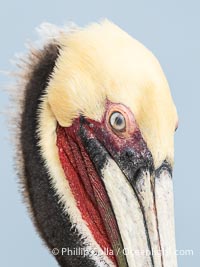
Nictitating Membrane Partially Covering Brown Pelican Eye. The nictitating membrane, or nictating membrane, is a translucent membrane that forms an inner eyelid in birds, reptiles, and some mammals. It can be drawn across the eye to protect it while diving in the ocean, from sand and dust and keep it moist.
Species: Brown Pelican, Pelecanus occidentalis, Pelecanus occidentalis californicus
Location: La Jolla, California
Image ID: 40253
Species: Brown Pelican, Pelecanus occidentalis, Pelecanus occidentalis californicus
Location: La Jolla, California
Image ID: 40253
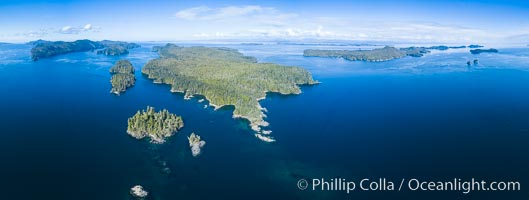
Balaklava Island and Browning Pass, location of the best cold water diving in the world, aerial photo.
Location: British Columbia, Canada
Image ID: 34485
Panorama dimensions: 4570 x 12090
Location: British Columbia, Canada
Image ID: 34485
Panorama dimensions: 4570 x 12090
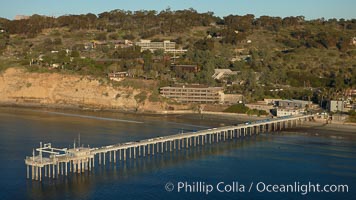
SIO Pier. The Scripps Institution of Oceanography research pier is 1090 feet long and was built of reinforced concrete in 1988, replacing the original wooden pier built in 1915. The Scripps Pier is home to a variety of sensing equipment above and below water that collects various oceanographic data. The Scripps research diving facility is located at the foot of the pier. Fresh seawater is pumped from the pier to the many tanks and facilities of SIO, including the Birch Aquarium. The Scripps Pier is named in honor of Ellen Browning Scripps, the most significant donor and benefactor of the Institution.
Location: Scripps Institution of Oceanography, La Jolla, California
Image ID: 22293
Location: Scripps Institution of Oceanography, La Jolla, California
Image ID: 22293